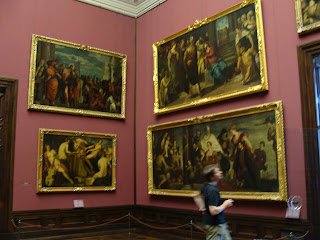Can there be anyone who is not familiar with the two cheeky little cherubs who perch so cutely at the feet of the “Sistine Madonna”? They have been enchanting visitors to the Gemäldegalerie Alte Meister for more than 250 years now. By purchasing the “Sistine Madonna”, August III, Elector of Saxony and King of Poland, fulfilled his long-held desire to become the owner of an original work by Raphael.
Most of the major works to be admired in the Gemäldegalerie Alte Meister today were assembled within a period of little more than half a century. Although it is true that numerous paintings were already held in the Kunstkammer of the Electors of Saxony, which was founded in 1560, the systematic collecting of paintings did not begin until the reigns of August the Strong (1670 – 1733) and, in particular, his son August III (1696 – 1763). His agents purchased 16th, 17th and 18th-century masterpieces all over Europe. In 1746 they succeeded in making a particularly spectacular purchase: 100 masterpieces were bought from the collection of the Duke of Modena, all of them works by top-ranking artists and thus of inestimable value. The following year, the Gemäl¬degalerie was moved to the converted Electoral Stable Building on the Jüdenhof. In 1855 the gallery building designed by Gottfried Semper and constructed next to the Zwinger was opened. This was one of the most important museum projects of the 19th century in Germany, and it is here that the collection is still housed today. During the Second World War, most of the paintings were evacuated for safe-keeping and were not damaged. After the end of the war, the paintings – like the holdings of many other museums – were taken by the Red Army to Moscow and Kiev. Following the return of the art treasures in 1955/56, reconstruction work began on the gallery building, which had been severely damaged in the war, and shortly afterwards it was reopened. The two cherubs are still idly lolling at the bottom of the picture, apparently oblivious to their countless admirers.












No comments:
Post a Comment